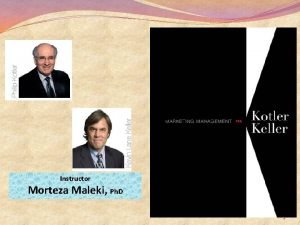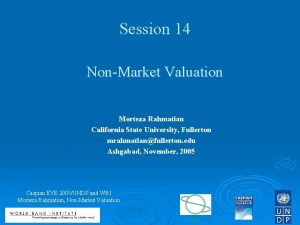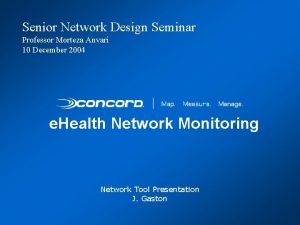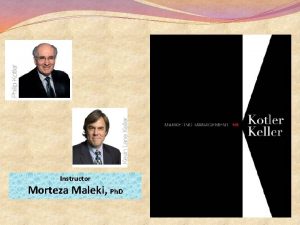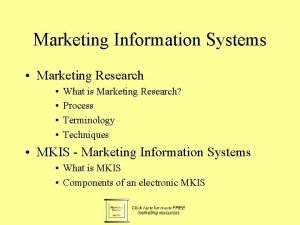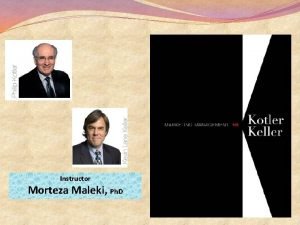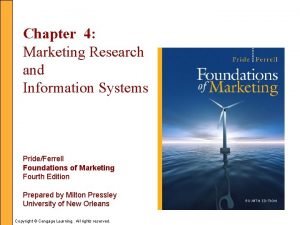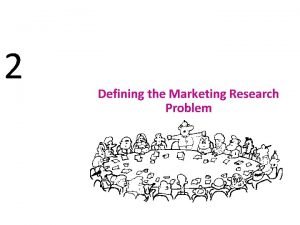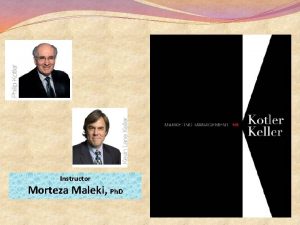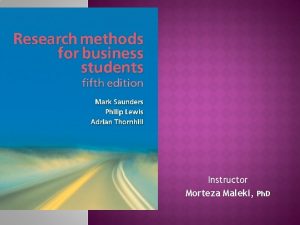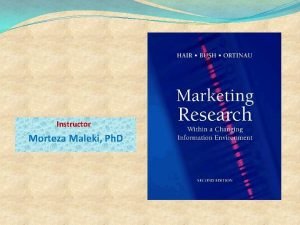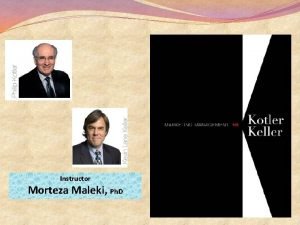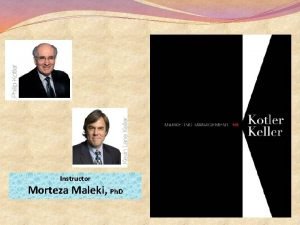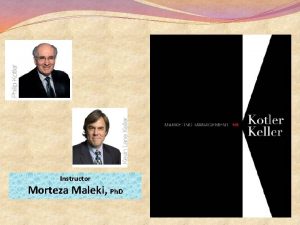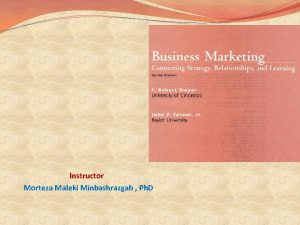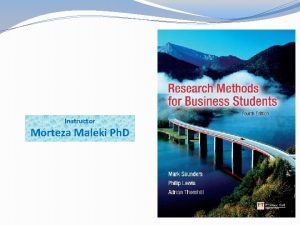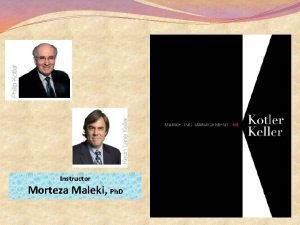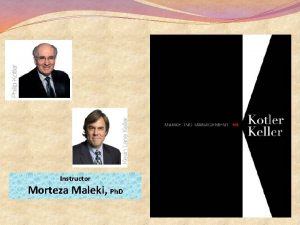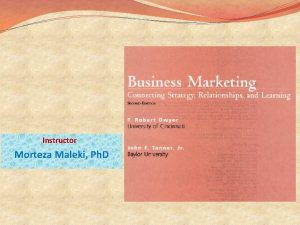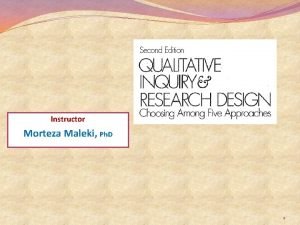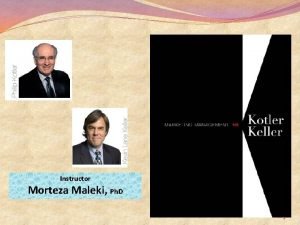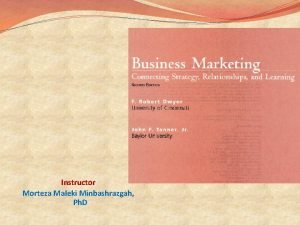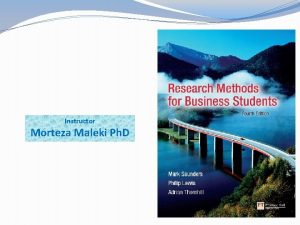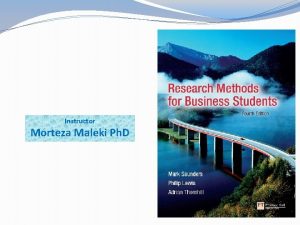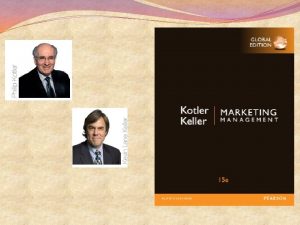Instructor Morteza Maleki Ph D The Marketing Research











































- Slides: 43

Instructor Morteza Maleki, Ph. D


The Marketing Research Systems ü It is the job of marketing researcher to produce insight into the customer’s attitudes & buying behavior. ü Marketing Insights provide diagnostic info about how & why we observe certain effects in the market place, & what that means to marketers. ü MARKETING RESEARCH is the systematic design, collection, analysis, & reporting of data & findings relevant to specific marketing situation facing the company. 3

The Marketing Research Systems Marketing Research Firms fall into three categories; 1. SYNDICATED-SERVICE RESEARCH FIMS; they gather consumer & trade info, which they sell for a fee. 2. CUSTOM MARKETING RESEARCH FIRMS; they design & carry out research studies for various clients based on specific beliefs. 3. SPECIALITY-LINE MARKETING RESEARCH FIRMS; they provide specialized research services such as developing a research brief (for this they may hire academics and freelancers), collecting field data, & preparing data analysis & reports for other firms. 4

The Marketing Research Process Effective marketing research follows six steps; 1. Define the Problem, the Decision Alternative, & the Research 2. 3. 4. 5. 6. Objectives Develop the Research Plan Collect the Information Analyze the Information Present the Findings, & Make the Decision 5

The Marketing Research Process Step (1) DEFINE THE PROBLEM, THE DECISION ALTERNATIVE, & THE RESEARCH OBJECTIVES Problems should not be defined either too broadly or too narrowly; ü A broad or vague definition leads to excessive wastage of resources. ü Too narrow a definition leads to inadequate data or info required to make an effective decision. ü Clarity on the following helps define the problem appropriately; ü ü What is to be researched (the content, the scope)? Why is it to be researched (the decisions that are to be made)? ü The end product of this step has to be a clear definition of the problem & research objectives. 6

The Marketing Research Process Step (2) DEVELOP THE RESEARCH PLAN The second steps in marketing research involves decisions on 1. Data Sources, 2. Research Approaches 3. Research Instruments 4. Sampling Plan, & 5. Contact Methods 7

The Marketing Research Process 1. Data Sources The researcher can gather secondary data, primary data, or both. ü SECONDARY DATA are data that were collected for another purpose, & already exist somewhere. ü PRIMARY DATA are freshly gathered data for a specific purpose or for a specific research project. ü Researchers usually start their investigation by examining secondary data to see whether the problem can be partly or wholly solved without collecting costly primary data. ü When the required data do not exist or are dated, inaccurate, incomplete, or unreliable, the researcher will have to collect primary data. 8

The Marketing Research Process 2. Research Approach Primary data can be collected in five ways; 1. 2. 3. 4. 5. OBSERVATION FOCUS GROUPS SURVEYS BEHAVIORAL DATA, & EXPERIMENTS 9

The Marketing Research Process OBSERVATIONAL RESEARCH ü Researchers can gather fresh data by observing the relevant actors & settings, unobtrusively observing as they shop or as they consume products. ü Sometimes, they equip consumers with pagers & instruct them to write down what they’re doing whenever prompted, or they hold informal interviewed sessions at a café or bar. ü Photographs can also provide a wealth of detailed info. 10

The Marketing Research Process ETHNOGRAPHIC RESEARCH ü ü It is a particular observational research approach that uses concepts & tools from anthropology and other social science disciplines to provide deep understanding of how people live or work. The goal is to immerse the researcher into consumer’s lives to uncover unarticulated desires that might not surface to any other form of research. Ethnographic research is not limited to consumer companies in developed markets. ü ü GE’s ethnographic study into plastic industry is the case in industrial markets using this approach. It is particularly useful in developing markets, especially far-flung areas, where companies do not know consumers as well. 11

The Marketing Research Process FOCUS GROUP RESEARCH ü A focus group is a gathering of six to ten people who are invited to spend a few hours with a skilled moderator in order to discuss a product, service, organization, or any other marketing entity. ü The moderator needs to be objective, knowledgeable, & skilled in group dynamics. ü Participants are normally offered some gifts or incentives for attending the meeting; the meeting is typically held in pleasant surroundings, & refreshments are served. 12

The Marketing Research Process FOCUS GROUP RESEARCH (con…) ü The moderator usually starts with a broad question & then helps the group move through various aspects of the entity being discussed, encouraging free & easy discussion. ü ü The key role of the moderator is to keep the discussion “focused” on the relevant theme while allowing deep feelings & thoughts to emerge through the group dynamics. Transcripts prepared from recordings are subsequently analyzed to understand consumer beliefs, attitudes, & behavior. 13

The Marketing Research Process SURVEY RESEARCH ü Surveys are best suited for descriptive research. ü Companies undertake surveys to learn about people knowledge, beliefs, preferences, & satisfaction. ü It requires development of a survey instrument, usually questionnaire, which the respondents are asked to fill up. 14

The Marketing Research Process BEHAVIORAL DATA ü Customers’ actual purchases reflect preferences & are normally more reliable than memory-based statements made in surveys. ü Observations have shown that many high-income group customers do not buy expensive consumer goods, while some low -level income consumers end up buying expensive products, contrary to their stated preferences in the surveys. 15

The Marketing Research Process EXPERIMENTAL RESEARCH ü The most scientifically valid research ü Its purpose is to capture cause-&-effect relationships by eliminating competing explanations of the observed findings. ü To the extent that the design & execution of the experiment eliminate alternative hypotheses that might explain the results, research & marketing managers can have confidence in the conclusions. ü Experiments call for selecting matched groups of subjects, subjecting them to different treatments, controlling the extraneous variables, & checking whether the observed response differences are statistically significant. 16

The Marketing Research Process 3. Research Instrument Marketing researchers have a choice of three main research instruments in collecting primary data; 1. 2. 3. Questionnaires Qualitative Measures, & Technological Devices 17

The Marketing Research Process QUESTIONNAIRES ü ü A questionnaire consists of a set of questions presented to respondents; because of its flexibility, it is by far the most common instrument used to collect primary data. The form, wording, & sequence of the question can all influence the response. 1. Closed-end Questions specify all the possible answers & provide answers that are easier to interpret & tabulate. 2. Open-ended Questions allow respondents to answer in their own words & often reveal more about how people think. ü They are especially useful in exploratory research, where the researcher is looking for insight into how people think rather than measuring how many people think a certain way. 18

The Marketing Research Process QUALITATIVE MEASURES Consumer actions do not always match their answers to survey questions. ü Qualitative Research Techniques are relatively unstructured measurement approaches that permit a range of possible responses. ü Due to the freedom afforded both researchers in their probes & consumers in their responses, qualitative research can often be a useful first step in exploring consumers’ brand & product perceptions. 19

The Marketing Research Process Drawback of Qualitative Measures 1. Marketers must temper the in-depth insights that emerge with the fact that the samples are often very small & may not necessarily generalize to boarder populations. 2. Different researchers examining the same qualitative results may draw very different conclusions. 20

The Marketing Research Process TECHNOLOGICAL DEVICES ü Technological devices are occasionally useful in marketing research. ü Technology has now advanced to such a degree that marketers can use devices such as skin sensors, brain wave scanners, & full body scanners to get consumer responses. ü ü For instance, TACODA, an advertising technology company, is studying the eye movements & brain activity of web surfers to see which ad grabs their attention. Technology has replaced the diaries that participants in media surveys used to keep. 21

The Marketing Research Process 4. Sampling Design This calls for three decisions 1. ü 2. ü ü 3. ü ü Sampling unit; who should we survey? Once they have determined the sampling unit, marketers must develop a sampling frame so that everyone in the target population has an equal or known chance of being sampled. Sample size; how many people should we survey? Large samples give more reliable results, but it’s not necessary to sample the entire target population to achieve reliable results. Samples of less than 1% of a population can often provide good reliability, with a credible sampling procedure. Sampling procedure; how should we choose the respondents? Probability sampling allows confidence limits to be calculated for sampling error & makes the sample more representative. When the cost or time to use probability sampling is too high, marketing researchers will take nonprobability sample. 22

The Marketing Research Process 5. Contact Methods Now the marketing researcher must decide how to contact the subjects: by mail, by telephone, in person, or online. 1. MAIL QUESTIONNAIRE; ü It is the best way to reach people who would not give personal interviews or whose responses might be biased or distorted by the interviewers. ü It requires simple & clearly worded questions. ü The response rate is usually low or slow. 23

The Marketing Research Process 2. TELEPHONE INTERVIEW; ü ü ü It is the best method for gathering info quickly; the interviewer is also able to clarify questions if respondents do not understand them. The response rate is typically higher than in the case of mailed questionnaires. Yet, the interviews have to be short & not too personal. 3. PERSONAL INTERVIEW; ü ü It is the most versatile method; the interviewer can ask more questions & record additional observations about the respondent, like dress & body language. Yet, it is the most expensive method, subject to interviewer bias, & requires more administrative planning & supervision. 24

The Marketing Research Process ONLINE INTERVIEW; There are so many ways to use the Internet to do research. ü The company can embed a questionnaire on its website in different ways & offer an incentive to answer it; or it can place a banner on a frequently visited site such as Yahoo!, inviting people to answer some questions & possibly win a price. ü Marketers can also sponsor a chat room or bulletin board & introduce questions from time to time or host a real time consumer panel or virtual focus group. ü The company can learn about individuals who visit its site by tracking how they clickstream through the website & move to other sites. ü The company can post different prices, use different headlines, & offer different product features on different websites or at different times to learn the relative effectiveness of its offerings. 25

The Marketing Research Process Step (3) COLLECT THE INFORMATION The data collection phase of marketing research is generally the most expensive & the most prone to error. ü Four major problems arise in surveys; 1. 2. 3. 4. Some respondents will not be at home & must be contacted again or replaced. Other respondents will refuse to cooperate. Still others will give biased or dishonest answers. Some interviewers will be biased or dishonest. 26

The Marketing Research Process ü Data collection methods are rapidly improving due to the computers & telecommunication advances. ü One of the biggest obstacles to collecting info internationally is the need to achieve consistency. ü ü In global research, we have to adapt culturally to how, where, & with whom we are doing the research. A simple research study conducted globally becomes much more complicated as a result of cultural nuances, & it’s necessary for us to be sensitive to those nuances in data collection & interpretation. 27

The Marketing Research Process Step (4) ANALYSE THE INFORMATION ü It is extracting findings by tabulating the data & developing frequency distributions. ü The researchers now compute averages & measure of dispersion for the major variables & apply some advance statistical techniques & decision methods in the hope of discovering additional findings. ü They may test different hypotheses & theories, applying sensitivity analysis to test assumption & the strength of the conclusions. 28

The Marketing Research Process Step (5) PRESENT THE FINDINGS ü The researcher presents findings relevant to the major marketing decisions facing management. ü Researchers increasingly are being asked to play a more proactive, consulting role in translating data & info into insights & recommendations. ü They are also considering ways to present research findings in as understandable & compelling a fashion as possible. 29

The Marketing Research Process Step (6) MAKE THE DECISION ü Research findings only provide additional info & insights to the managers. ü Depending on their confidence in the findings, managers decide to use it, discard it, or carry out more research. A growing number of organizations are using a Marketing Decision Support Systems (MDSS) to help their marketing managers make better decisions. ü MDSS is a coordinated collection of data, systems, tools, & techniques, with supporting software & hardware, by which an org gathers & interprets relevant info from business & environment & turns it into a basis for marketing action. 30

Barriers to the Effective Use of Marketing Research 1. A narrow conception of the research 2. Uneven caliber of researchers 3. Poor framing of the problem 4. Late & occasionally erroneous findings 5. Personality & presentational differences 31

Barriers to the Effective Use of Marketing Research 32

Measuring Marketing Productivity An important task of marketing research is to assess efficiency & effectiveness of marketing activities. ü Marketers are increasingly being held accountable for their investments and must be able to justify marketing expenditures to senior management. Two complementary approaches to measuring marketing productivity are; 1. 2. Marketing Metrics, & Marketing-mix Modeling 33

Measuring Marketing Productivity 1. MARKETING METRICS ü It is a set of measures that helps marketers to quantify, compare, & interpret their marketing performance. ü They can be used by brand managers to justify & design marketing programs & by senior management to decide on financial allocations. ü Firms must give priority to measuring & reporting marketing performance through marketing metrics. 34

Measuring Marketing Productivity Evaluation can be split into two parts; SHORT-TERM RESULTS v They often reflect profit & loss concerns as shown by sales turnover, shareholder value, or some combination of two. CHANGES IN BRAND EQUITY v They could include customer awareness, attitudes, & behaviors; market share; relative price premium; number of complaints; distribution & availability; total number of customers; perceived quality, loyalty, & retention. 35

Measuring Marketing Productivity 36

Measuring Marketing Productivity 2. MARKETING-MIX MODELLING � Marketing mix models analyze data from a variety of sources, such as retailer scanning data, company shipment data, pricing, media, & promotion spending data, to understand more precisely the effects of specific marketing activities. � To deepen understanding, marketers can conduct multivariate analyses, such as regression analysis, to sort through how each marketing element influences marketing outcomes such as brand, sales or market share. 37

Measuring Marketing Productivity MARKETING DASHBOARDS � Management can assemble a summary set of relevant internal & external measures in a marketing dashboard for synthesis & interpretation. Marketing Dashboards are like the instrument panel in a car or plane, visually displaying real-time indicators to ensure proper functioning. � They are only as good as the info on which they’re based, but sophisticated visualization tools are helping bring data alive to improve understanding & analysis. 38

Measuring Marketing Productivity 39

Measuring Marketing Productivity Companies should include two key market-based scorecards reflecting performance as input to the marketing dashboards; 1. A CUSTOMER-PERFORMANCE SCORECARD records how well the company is doing year after year on such customer-based performance, like the followings; 1. 2. 3. Percentage of new customers to average number of customers, Percentage of lost customers to average number of customers, Percentage of win-back customers to average number of customers, etc. 2. A STAKEHOLDER-PERFORMANCE SCORECARD tracks the satisfaction of various constituencies who have a critical interest in & impact on the company’s performance: 1. 2. Employees, suppliers, banks, distributors, retailers, & stockholders. Management should take action when one or more groups register increased or abovenorm levels of dissatisfaction. 40

Measuring Marketing Productivity 41

Measuring Marketing Productivity 42

The End
 Morteza maleki
Morteza maleki Example of data gathering procedure
Example of data gathering procedure Insertion sort pseudocode
Insertion sort pseudocode Morteza rahmatian
Morteza rahmatian Morteza anvari
Morteza anvari Morteza
Morteza Cost analysis requirements description
Cost analysis requirements description Morteza farajian
Morteza farajian Morteza farajian
Morteza farajian Isaep
Isaep Morteza farajian
Morteza farajian Finer segmentation strategies
Finer segmentation strategies Marketing information systems and marketing research
Marketing information systems and marketing research Define marketing information management
Define marketing information management Marketing information systems and marketing research
Marketing information systems and marketing research Marketing information systems and marketing research
Marketing information systems and marketing research Marketing information systems and marketing research
Marketing information systems and marketing research Marketing decision problem
Marketing decision problem Lo más importante en la tipología de los participantes
Lo más importante en la tipología de los participantes Basic instructor course texas
Basic instructor course texas Basic instructor course texas
Basic instructor course texas Basic instructor course tcole
Basic instructor course tcole Pepperball training manual
Pepperball training manual Neither of my two suitcases are adequate for this trip
Neither of my two suitcases are adequate for this trip Instructor vs teacher
Instructor vs teacher Ospfv
Ospfv Mptc instructor
Mptc instructor Tcole advanced instructor course
Tcole advanced instructor course Basic instructor course #1014
Basic instructor course #1014 Drawing and painting the virtual instructor
Drawing and painting the virtual instructor Nfpa 1403
Nfpa 1403 Human factors instructor
Human factors instructor Instructor operating station
Instructor operating station Catia instructor
Catia instructor Instructor
Instructor Instructor responsibilities and professionalism lesson plan
Instructor responsibilities and professionalism lesson plan Tcole 1014 basic instructor course
Tcole 1014 basic instructor course Usmc jrotc vacancies
Usmc jrotc vacancies How to become an nrp instructor mentor
How to become an nrp instructor mentor Utp cable
Utp cable Cbrf wisconsin registry
Cbrf wisconsin registry Nra certified instructor logo
Nra certified instructor logo Naismith was an instructor of
Naismith was an instructor of Please clean your own room
Please clean your own room
